|
|
|
Sort Order |
|
|
|
Items / Page
|
|
|
|
|
|
|
| Srl | Item |
| 1 |
ID:
096273
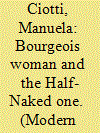

|
|
|
|
|
| Publication |
2010.
|
| Summary/Abstract |
This paper explores the interplay between development, identity politics and middle-class aspirations amongst low-caste Chamar women in rural north India. It argues that this interplay has reinvigorated notions of women's domesticity, education and modern conjugality as they emerged in the reforms and 'modernising' efforts of sections of Indian society, since the nineteenth century, in their encounter with the colonial 'civilising mission'. It will show how the long-term effects of this 'legacy', through its reconfiguration and appropriation by members from a low caste, have affected a historically marginalised community in their pursuit of middle-class aspirations. In addition to the criticality of Indian women and their gender roles as 'sites' where nation and community transformations are symbolically and practically negotiated, scholars of South Asia have also highlighted the separation between historical and anthropological discourses on women. This paper brings these discourses together and addresses this separation by showing that Chamar appropriation of the 'modernising' agenda has initiated a dual process. On the one hand, a minority of women have embarked on an embourgeoisement trajectory predicated on education, 'modern motherhood' and aspirations to white collar employment, and on the other hand, underprivileged women (with their 'unfit' personas) have become increasingly vulnerable to stigmatisation as a result of being in 'menial labour'. It is further argued that dialectic study of the 'two [groups of] Chamar women' will provide an insightful lens through which inner conflicts within low-caste communities in contemporary India may be understood, and suggests that there are contradictory trends concerning women, their development prospects, and their membership within the nation.
|
|
|
|
|
|
|
|
|
|
|
|
|
|
|
|
| 2 |
ID:
096272
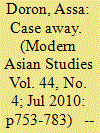

|
|
|
|
|
| Publication |
2010.
|
| Summary/Abstract |
Mayawati's recent victory, in May 2007, in the Uttar Pradesh elections has been hailed as a 'spectacular display of subaltern power'. The questions remain: who are these subalterns? To what extent do they form a coherent block, with similar fears, hopes and aspirations, and how are subalterns' visions of the state, social justice and equality articulated? This paper explores some of these questions, by examining the example of the boatman community in Banaras, belonging to the Mallah (Nishad) caste, and the strategies they use to be heard as legitimate citizens of the state. Such strategies and techniques reveal a sophisticated and organized apparatus of caste and community associations that call into question some recent theoretical formulations of the Indian state as one dominated and manipulated by powerful elites, while subalterns remain passive or, at best, compliant.
|
|
|
|
|
|
|
|
|
|
|
|
|
|
|
|
| 3 |
ID:
096277
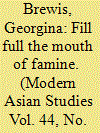

|
|
|
|
|
| Publication |
2010.
|
| Summary/Abstract |
This paper considers non-governmental famine relief in India during 1896-1898 and 1899-1901. It details the efforts of a broad spectrum of middle-class Indians, Christian missionaries, British non-officials and off-duty civil servants who were drawn into voluntary service on semi-official committees which were responsible for distributing record sums raised through international appeals. It also explores the extension of relief work by independent agencies in the 1890s. The paper considers evolving British attitudes to indigenous relief methods and the sometimes fraught relations between government and voluntary agencies. It suggests that voluntary famine relief activities during the 1890s mark a transition from traditional religious philanthropy to organised social service. Voluntary relief at this time differed from earlier responses to famine hunger because it was marked by fundraising, co-operation with other agencies and the personal service of volunteers. In conclusion, it is shown that participation in relief in the 1890s inspired a new generation of educated Indians to channel their nationalism into practical social service after 1900.
|
|
|
|
|
|
|
|
|
|
|
|
|
|
|
|
| 4 |
ID:
096271
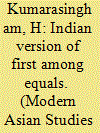

|
|
|
|
|
| Publication |
2010.
|
| Summary/Abstract |
When India gained independence in August 1947 the world watched with excitement as well as trepidation as to what would happen following this unique and major event. The political destiny of the world's largest democracy would lie in the hands of an infinitesimal portion of the population - the political executive. India's new institutions had new operators to act in new conditions. There were few precedents. Within this Westminster system, refounded in India with its emphasis on executive flexibility and ambiguity, the leading political figures often had conflicting opinions and interpretations as to their powers. The relationship between Nehru as Prime Minister and other leading political figures, such as Patel as deputy Prime Minister, Prasad as President, and their definitions of their roles, would forge a new India. This paper revisits those debates and ideas in the first decade following independence, which allow greater understanding of the workings and conventions of today's Indian executive.
|
|
|
|
|
|
|
|
|
|
|
|
|
|
|
|
| 5 |
ID:
096275
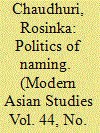

|
|
|
|
|
| Publication |
2010.
|
| Summary/Abstract |
Henry Derozio, India's first modern poet, used the pseudonym 'An East Indian' for several poems he published in his lifetime, and he may have used it again in a heated controversy that played itself out in the correspondence columns of the India Gazette, Calcutta's leading newspaper, from May 26 to June 5, 1825. The occasion was an editorial comment upon a community of office-goers in the city-called, at the time, 'sircars'-who had set up a literary association. This editorial was widely perceived to be reactionary, and civil society responded vigorously in protest at the injustice. The sequence of editorials and letters published on this issue, which seem to have been written by Englishmen, East Indians and Indians alike, demonstrate a remarkable liberalism of spirit and a free-thinking attitude to ethnicity that was soon to disappear in the stiffening boundaries of a racially divided society. 1825 was also the year that Derozio began to publish prolifically in the poetry columns of newspapers and periodicals in the city; by the time he died, in 1831, he had published two books of poems in 1827 and 1828 and had created a revolution of sorts among the radicalised youth of the Hindu College, from which he had been dismissed for his role in their alienation from tradition. In 1831, a few months before his death, Derozio addressed a mammoth meeting called to commemorate the return of John Ricketts, the East Indian representative, from his mission to the English houses of Parliament for a redressal of the community's grievances. Using these two lost occasions-the public correspondence and the meeting-both concerned with the politics of naming, this paper will attempt to present the early radical interventions of the mixed-race community in initiating a discourse of civic rights and human dignity which led, ultimately, to organised attempts at constitutional change and political reform in India, whose estimation is underrated in present-day contexts.
|
|
|
|
|
|
|
|
|
|
|
|
|
|
|
|
| 6 |
ID:
096270
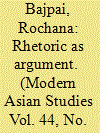

|
|
|
|
|
| Publication |
2010.
|
| Summary/Abstract |
Social justice is a key concept in the theory and practice of affirmative action. In India, social justice has come to serve as shorthand for affirmative action for disadvantaged groups, mainly lower castes. This paper provides a detailed analytical interpretation of social justice in a landmark legislative debate on quotas in India, namely the 1990 Mandal debate. It unpacks political rhetoric to reveal distinct conceptions of social justice, shows that claims for quotas for Other Backward Classes (OBCs) in the bureaucracy drew substantially on principles of social justice and democracy and argues that, despite appearances, several arguments for OBC representation in government jobs were compatible with the principle of merit. In doing so, the paper demonstrates that contrary to common opinion, political rhetoric deserves close attention. A reconstruction of political arguments over affirmative action advances understanding of some puzzling features of lower-caste politics in India. It also illuminates important questions in political theory debates on social justice.
|
|
|
|
|
|
|
|
|
|
|
|
|
|
|
|
| 7 |
ID:
096274
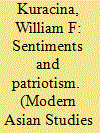

|
|
|
|
|
| Publication |
2010.
|
| Summary/Abstract |
This paper considers the extent to which Subhas Chandra Bose and the Indian National Army (INA) contributed to India's liberation from British imperialism. The fundamental issue examined is why leaders of the Indian National Congress appropriated the INA legacy, contrary to two decades of non-violent struggle and regardless of the incompatibility of Bose's ideology and strategic vision. Drawing on published sources that chart policy decisions and illustrate the attitudes of leading actors in the formulation of Congress policy, this paper hypothesizes that Congress leaders defended INA prisoners-of-war and questions why the Congress apparently abandoned its long-established principles for immediate political gains, only to re-prioritize anew India's national interests once the public excitement over the INA had quietened. It illustrates that the Congress's overt and zealous defence of the INA was intended to harness public opinion behind an all-India issue rooted in sentimentalism and patriotism. The paper concludes that such support was crucial to the Congress's post-war electioneering campaign and was designed to counter the Muslim League's equally emotive electoral messages.
|
|
|
|
|
|
|
|
|
|
|
|
|
|
|
|
|
|
|
|
|